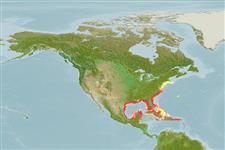Teleostei (teleosts) >
Carangaria/misc (Various families in series Carangaria) >
Polynemidae (Threadfins)
Etymology: Polydactylus: Greek, poly = a lot of + greek, daktylos = finger (Ref. 45335).
More on author: Girard.
Environment: milieu / climate zone / depth range / distribution range
Ecology
Marine; demersal; depth range 5 - 66 m (Ref. 32117), usually 5 - 16 m (Ref. 32117). Subtropical; 42°N - 18°N, 98°W - 71°E (Ref. 57343)
Western Atlantic: New York and along the coast to the western coast of Yucatán, Mexico (Ref. 57343). Some authors report this species as occurring throughout northern South America (Ref. 5217).
Length at first maturity / Size / Weight / Age
Maturity: Lm 19.0, range 17 - 21 cm
Max length : 33.0 cm TL male/unsexed; (Ref. 5217); common length : 25.0 cm TL male/unsexed; (Ref. 5217)
Occurs on sand or mud bottoms and on beaches, especially on the surf (Ref. 57343).
Life cycle and mating behavior
Maturities | Reproduction | Spawnings | Egg(s) | Fecundities | Larvae
Motomura, H., 2004. Threadfins of the world (Family Polynemidae). An annotated and illustrated catalogue of polynemid species known to date. FAO Spec. Cat. Fish. Purp. Rome: FAO. 3:117 p. (Ref. 57343)
IUCN Red List Status (Ref. 130435)
Threat to humans
Harmless
Human uses
Fisheries: minor commercial
Tools
Special reports
Download XML
Internet sources
Estimates based on models
Preferred temperature (Ref.
123201): 23.3 - 27.9, mean 26.4 °C (based on 459 cells).
Phylogenetic diversity index (Ref.
82804): PD
50 = 0.5000 [Uniqueness, from 0.5 = low to 2.0 = high].
Bayesian length-weight: a=0.00407 (0.00237 - 0.00700), b=3.07 (2.92 - 3.22), in cm total length, based on LWR estimates for this species & Genus-body shape (Ref.
93245).
Trophic level (Ref.
69278): 3.6 ±0.5 se; based on size and trophs of closest relatives
Resilience (Ref.
120179): High, minimum population doubling time less than 15 months (tm<1).
Fishing Vulnerability (Ref.
59153): Low vulnerability (23 of 100).
Nutrients (Ref.
124155): Calcium = 166 [72, 461] mg/100g; Iron = 1.91 [0.82, 4.18] mg/100g; Protein = 20.1 [18.3, 21.9] %; Omega3 = 0.375 [0.180, 0.781] g/100g; Selenium = 47.3 [17.0, 122.9] μg/100g; VitaminA = 3.98 [1.05, 15.64] μg/100g; Zinc = 1.04 [0.62, 1.78] mg/100g (wet weight);
